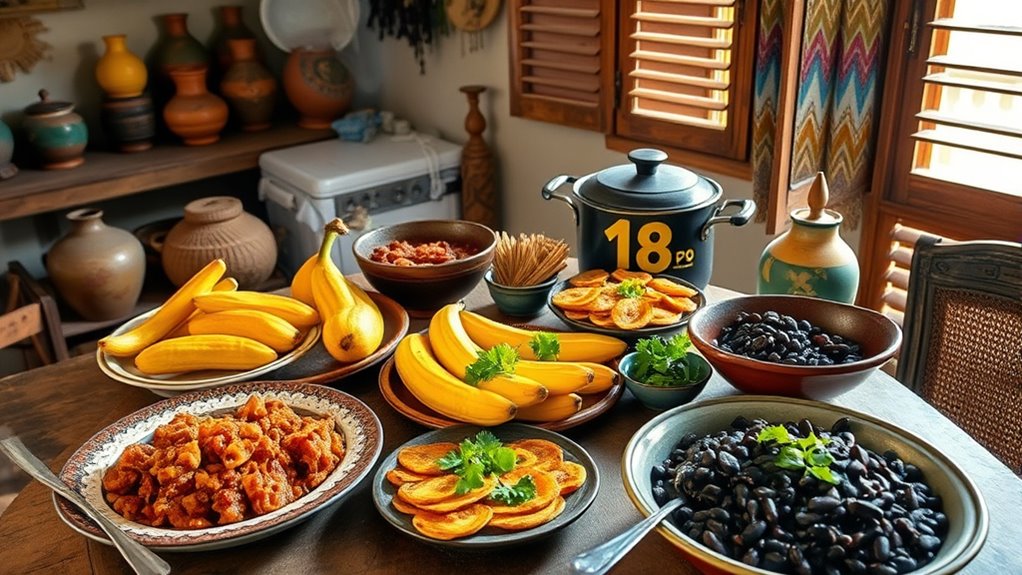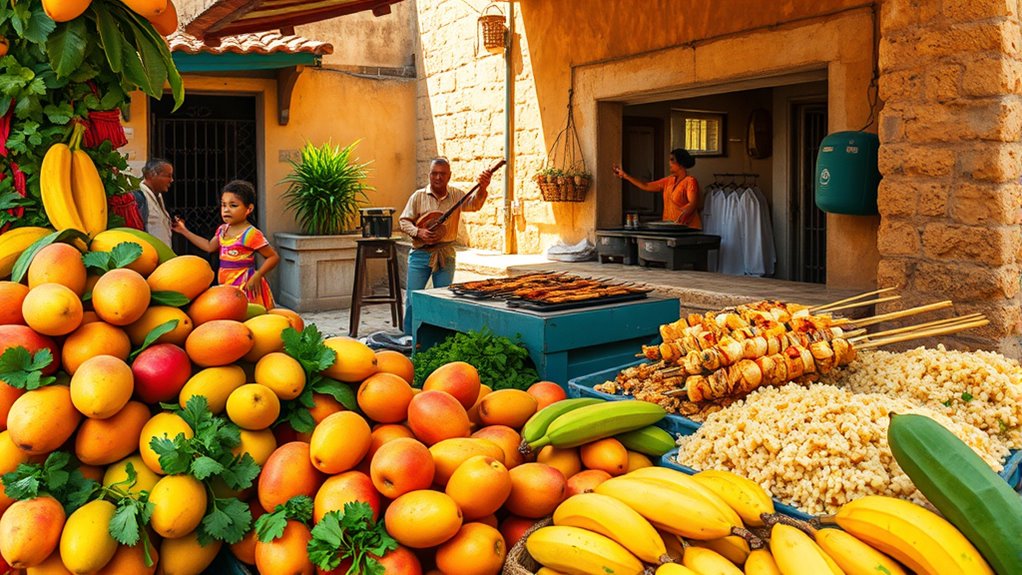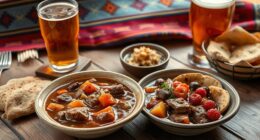Cuban cuisine blends indigenous Taíno, Spanish, and African influences, creating vibrant flavors and hearty dishes. Expect to enjoy rice, black beans, slow-cooked stews, and seafood seasoned with garlic, cumin, and citrus. Food is a key part of Cuban culture, fostering community and resilience through shared meals and street food. To discover how these traditions evolved and continue to thrive today, keep exploring the rich culinary heritage of Cuba.
Key Takeaways
- Cuban cuisine is a fusion of indigenous, European, and African influences, reflected in dishes like ropa vieja and Moros y Cristianos.
- Staple ingredients include rice, black beans, yuca, garlic, onions, and spices, creating rich, aromatic flavors.
- Cooking techniques such as slow-cooking, stewing, marinating, and open-fire roasting are central to traditional dishes.
- Food plays a vital role in Cuban society, serving as a means of community bonding, cultural expression, and historical resilience.
- Modern street food and fusion dishes incorporate international influences, showcasing Cuba’s evolving culinary scene.
Historical and Cultural Roots of Cuban Cuisine

The roots of Cuban cuisine run deep in the island’s history, shaped by a blend of indigenous, European, and African influences. You’ll notice Spanish colonization’s mark in dishes like ropa vieja, which reflect Canary Islands traditions. Indigenous Taíno people contributed root vegetables such as yuca and sweet potato, as well as stews like ajiaco. Africans brought spices, cooking techniques, and staples like black beans, which form the base of Moros y Cristianos. Caribbean climate provides seafood and tropical fruits, influencing many recipes. Over centuries, these cultures intertwined, creating a vibrant culinary tapestry. Migration from Spain, Africa, and the Caribbean added layers of flavor and technique. Today, Cuban cuisine embodies this history—rich, diverse, and rooted in resilience and adaptation. Recognizing the influence of culinary techniques from different cultures highlights how Cuban dishes have evolved through intercultural exchange.
Key Ingredients and Flavor Profiles

Cuban cuisine centers around bold, vibrant flavors achieved through a carefully curated set of key ingredients. Garlic, onions, and cumin form the flavor foundation, creating rich, aromatic dishes. Staples like rice, black beans, and yuca are versatile, featured in dishes such as Moros y Cristianos or congrí. You’ll also find peppers (not hot chiles), tomatoes, and bay leaves enriching stews and meats, adding depth. Citrus juices, especially bitter orange, and vinegar act as marinades and flavor enhancers, reflecting Spanish and Caribbean influences. Achote seeds and oregano add color and aroma, elevating every bite. Here’s a quick overview:
| Ingredient | Flavor Role |
|---|---|
| Garlic & Onions | Aromatic base for many dishes |
| Cumin & Oregano | Warm, earthy seasoning |
| Citrus & Vinegar | Brightens and tenderizes meats |
Additionally, the use of food preservation techniques helps develop layered flavors unique to Cuban culinary traditions.
Classic Dishes and Culinary Techniques

Have you ever wondered how traditional Cuban dishes come together with such rich flavors and textures? You’ll find that slow-cooking and stewing are key techniques, especially for hearty dishes like ropa vieja. These methods tenderize meats and blend spices, creating deep, layered flavors. When preparing rice and beans, you might cook them separately or together as Moros y Cristianos, allowing the beans to impart their color and taste. Marinating meats with citrus juice and garlic is common, tenderizing and flavoring simultaneously. Soups like ajiaco involve boiling a mixture of vegetables and meats, a practice rooted in indigenous and African traditions. You’ll also see the use of banana leaves and open-fire roasting during celebrations, adding authentic indigenous and Afro-Caribbean influences to traditional cooking. Additionally, incorporating emotional support during culinary traditions can enhance the overall experience and foster a sense of community.
The Role of Food in Cuban Society and History

Food in Cuba goes beyond sustenance; it reflects the island’s complex history, social dynamics, and cultural identity. You experience this through traditional dishes that tell stories of Spanish, African, and indigenous influences shaping daily life. Meals often serve as communal events, reinforcing family bonds and social cohesion, especially during celebrations and festivals. Food also mirrors Cuba’s political history, with scarcity fostering creativity and resourcefulness. During times of hardship, Cubans adapt recipes using accessible ingredients like rice, beans, and root vegetables, demonstrating resilience. Street food and shared meals remain essential in fostering community and preserving cultural traditions. Additionally, understanding raw food practices can shed light on how Cubans historically utilized local ingredients for nutrition and preservation. Ultimately, food in Cuba embodies more than nourishment; it’s a symbol of survival, identity, and collective memory across generations.
Modern Influences and Street Food Traditions

Modern influences and street food traditions in Cuba showcase how the island’s culinary scene continues to evolve while honoring its rich heritage. You’ll find traditional favorites like Cuban sandwiches and fritters sold from vibrant street stalls, blending classic flavors with contemporary twists. Urban centers like Havana serve fusion dishes that incorporate Chinese, Italian, and international ingredients, reflecting Cuba’s diverse cultural interactions. Due to economic constraints, many street vendors use frozen, canned, or locally available substitutes, which shape the taste and presentation of popular snacks. Desserts like flan and tropical fruits remain staples, showcasing Cuba’s abundant produce. You’re encouraged to explore these lively street scenes, where authentic flavors meet modern creativity, highlighting Cuba’s resilience and evolving culinary identity. Glycolic acid also plays a role in skincare routines, helping to improve skin texture and radiance, much like how traditional ingredients enhance the island’s culinary appeal.
Frequently Asked Questions
How Has Cuba’s Political History Shaped Its National Cuisine?
You see Cuba’s political history shaping its cuisine through scarcity and adaptation. When resources were limited, you notice how Cubans relied on affordable staples like rice, beans, and root vegetables. You’ll find hearty, filling dishes like ropa vieja and moros y cristianos that reflect resilience. Political upheavals also led to creative fusion, blending traditional ingredients with new influences, making Cuban food a symbol of survival and cultural identity amidst changing times.
What Are Traditional Cuban Desserts and Their Cultural Significance?
You’ll find Cuban desserts are a sweet explosion of history and culture. Flan, with its silky texture, embodies Spanish influence, while sweet plantains tell stories of African roots. Tarts made from tropical fruits celebrate Cuba’s bounty, and rice pudding reflects indigenous traditions. These treats aren’t just desserts—they’re edible history, connecting you to Cuba’s vibrant past, its resilience, and the sweet moments that unify its people.
How Do Regional Differences Influence Cuban Culinary Practices?
You’ll notice that regional differences greatly influence Cuban culinary practices. In Havana, you’ll find fusion dishes combining Spanish, African, and Caribbean flavors, reflecting urban diversity. In the countryside, traditional recipes like ajiaco and root vegetable stews dominate, emphasizing indigenous and African influences. Coastal areas rely heavily on seafood, while inland regions focus more on hearty, farm-fresh ingredients. These variations showcase Cuba’s rich, diverse cultural and geographic heritage.
What Role Do Street Foods Play in Everyday Cuban Life?
Street foods are the heartbeat of everyday Cuban life, serving as quick, flavorful bites that keep the city pulsing. You’ll find lively vendors offering sandwiches, fritters, and fresh tropical fruits, turning streets into open-air kitchens. These foods connect people, making meals accessible and affordable. They’re more than snacks—they’re cultural expressions, blending tradition and innovation, and turning every street corner into a vibrant tapestry of Cuban flavors and community spirit.
How Are Contemporary Fusion Dishes Impacting Traditional Cuban Flavors?
Contemporary fusion dishes are reshaping traditional Cuban flavors by blending local ingredients with international influences, like Chinese, Italian, and modern culinary trends. You might notice new techniques, spices, or ingredient combinations in urban restaurants, adding excitement and diversity. While these dishes introduce innovative flavors, they often respect core elements like garlic, cumin, and rice, helping you enjoy a dynamic culinary scene that honors Cuba’s rich food heritage while embracing global creativity.
Conclusion
As you explore Cuba’s rich culinary traditions, you’ll see how food reflects its history, culture, and vibrant spirit. From hearty classics to lively street eats, each dish tells a story of resilience and passion. Remember, you’re truly tasting a slice of history with every bite—Cuba’s flavors are a proof to that. So, immerse yourself and embrace the flavors that make Cuban cuisine a treasure trove of culture and history.










